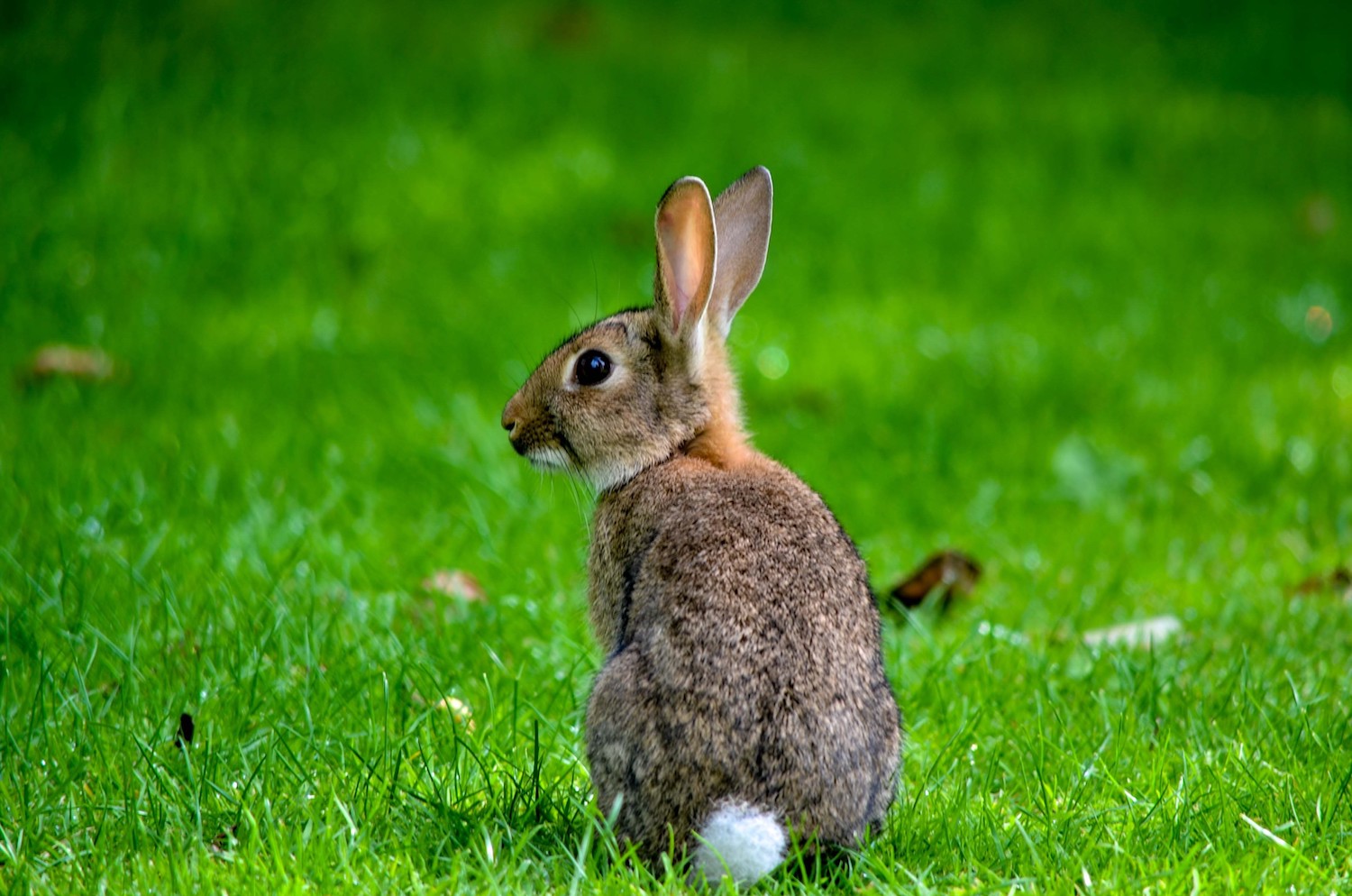Eastern Cottontail Rabbits, native to North America, are fascinating creatures with unique characteristics and behaviors. Here are seven essential facts about Eastern Cottontail Rabbits:
Fact 1: Physical Description of Eastern Cottontail Rabbits
- Fact 1: Physical Description of Eastern Cottontail Rabbits
- Size: Adult Eastern Cottontail Rabbits typically measure around 15-18 inches (38-45 centimeters) in length.
- Weight: These rabbits usually weigh between 2.5-3.5 pounds (1.1-1.6 kilograms).
- Appearance: They have a compact body with relatively short legs and large hind feet, which assist in their quick and agile movements.
- Fur: The fur of Eastern Cottontail Rabbits is soft and dense, characterized by a reddish-brown or grayish-brown color on their back and sides.
- Tail: One distinguishing feature is their fluffy white tail, which resembles a cotton ball and is the source of their name.
- Ears: Their ears are relatively long and have black tips, providing them with excellent hearing capabilities to detect potential predators.
- Eyes: They have large, round eyes that are positioned laterally on their head, allowing for a wide field of vision.
- Physical Adaptations: Eastern Cottontail Rabbits have strong hind legs, enabling them to run at high speeds (up to 18 miles/hour or 29 kilometers/hour) to escape from predators.
These physical characteristics of Eastern Cottontail Rabbits allow them to navigate their natural habitats efficiently and successfully evade danger when necessary.
Fact 2: Habitat and Distribution of Eastern Cottontail Rabbits
Eastern cottontail rabbits have a specific habitat and distribution that are important to understand. These rabbits are primarily found in North America, specifically in the eastern and central regions. They inhabit a variety of habitats, including forests, fields, farmlands, and suburban areas. They are well-adapted to living in areas with dense vegetation where they can find cover and easily access their preferred food sources.
Habitat and Distribution of Eastern Cottontail Rabbits are of great significance. Eastern cottontail rabbits have a wide range of distribution and can be found in different states across the United States, including New York, Ohio, Pennsylvania, and Virginia. They are also present in parts of Canada, including Ontario and Quebec. These rabbits are highly adaptable and can thrive in different types of environments with suitable vegetation and adequate hiding places.
Their habitat and distribution are influenced by several factors, including food availability, shelter options, and the presence of predators. They are herbivorous animals and feed on a variety of plant materials, including grasses, leaves, fruits, and vegetables. This wide range of food sources allows them to survive in diverse habitats.
The availability of suitable hiding places is crucial for their survival. Eastern cottontail rabbits prefer areas with thick vegetation, such as shrubs or tall grasses, where they can hide from predators like foxes, coyotes, and birds of prey. They also construct shallow burrows or use abandoned burrows of other animals for shelter.
The habitat and distribution of eastern cottontail rabbits are influenced by food availability, shelter options, and predation pressures. Their adaptability to different environments allows them to occupy a wide range of habitats across North America.
Fact 2: Habitat and Distribution of Eastern Cottontail Rabbits play a vital role in their survival. Eastern cottontail rabbits are known for their ability to reproduce rapidly, with females capable of producing up to three litters per year, each containing around four to seven young. This high reproductive rate helps maintain their population in their diverse habitats.
Fact 3: Diet and Feeding Habits of Eastern Cottontail Rabbits
The diet and feeding habits of Eastern Cottontail Rabbits, as mentioned in Fact 3, are crucial for their survival and well-being.
Eastern Cottontail Rabbits have a herbivorous diet, mainly consisting of grasses, leaves, flowers, and bark. They are selective feeders, meaning they choose specific plant parts based on their nutritional value and taste preferences, which helps them maintain a balanced diet.
Their diet primarily includes plants with high fiber content, such as clover, dandelion, and alfalfa. Additionally, they consume a variety of wildflowers, twigs, and buds. Throughout the day, Eastern Cottontail Rabbits are known to graze, and their feeding patterns can vary depending on the availability of food and the seasons.
To stay hydrated, it is crucial for Eastern Cottontail Rabbits to consume a sufficient amount of water. While they obtain most of their water intake from the plants they consume, they may also seek out water sources like ponds or streams when necessary.
If you encounter an Eastern Cottontail Rabbit in your garden and want to protect your plants, consider creating barriers or installing fencing to deter them. Offering designated areas with rabbit-friendly plants can help redirect their attention from your cherished vegetation.
Understanding the diet and feeding habits of Eastern Cottontail Rabbits, as highlighted in Fact 3, can assist in providing the necessary resources for their survival and coexistence with humans.
Fact 4: Reproduction and Life Cycle of Eastern Cottontail Rabbits
Eastern cottontail rabbits have a fascinating reproduction and life cycle. Here are the key facts:
1. Breeding season: Eastern cottontail rabbits breed throughout the year, with peak activity occurring from February to September. They are known to have multiple litters during this time.
2. Gestation period: The gestation period for eastern cottontail rabbits lasts around 28 to 35 days, depending on various factors such as temperature and food availability.
3. Litter size: Eastern cottontail rabbits typically have litters consisting of 3 to 8 babies, known as kits. Litter sizes can vary, and larger litters have been recorded.
The female rabbit constructs a nest, known as a form, where she gives birth and cares for her kits. She only visits the nest once or twice a day to nurse them, as her scent may attract predators.
5. Weaning: The kits are weaned at around 3 to 4 weeks of age. By this time, they are already starting to explore their surroundings and eat vegetation.
6. Independence: Eastern cottontail rabbits reach sexual maturity at around 2 to 3 months of age. Once they are independent, they leave their mother’s territory to establish their own.
7. Life span: In the wild, eastern cottontail rabbits have an average lifespan of 1 to 2 years due to predation and environmental factors. Captive rabbits can live up to 9 years.
Understanding the reproduction and life cycle of eastern cottontail rabbits can help us appreciate their role in the ecosystem and their ability to adapt to changing environments.
When observing eastern cottontail rabbits, it is essential to maintain a respectful distance, as excessive human interference can disrupt their natural behavior and potentially stress them. Enjoy observing these fascinating creatures from afar and let them thrive in their natural habitat.
Fact 5: Behavior and Adaptations of Eastern Cottontail Rabbits
Fact 5: Behavior and Adaptations of Eastern Cottontail Rabbits
Eastern cottontail rabbits are fascinating creatures, showcasing specific behaviors and unique adaptations that allow them to thrive in their habitats.
1. Primarily crepuscular, Eastern cottontail rabbits are most active during dawn and dusk. They engage in social interactions and forage for food during these times.
2. To evade predators, these rabbits heavily rely on their exceptional speed and agility. They can reach impressive speeds of up to 18 miles per hour, enabling them to swiftly escape any potential threats.
3. Notably, when sensing danger, Eastern cottontail rabbits have the amazing ability to freeze in place. By remaining motionless, they utilize their natural camouflage to blend seamlessly with their surroundings, making it challenging for predators to spot them.
4. As a form of communication, these rabbits exhibit a behavior known as “foot thumping.” They forcefully thump their hind legs on the ground to warn others of potential dangers. This serves as a crucial warning signal within their community.
5. Similar to many other rabbit species, Eastern cottontails possess adaptations that aid in their survival. Their large ears provide exceptional hearing capabilities, allowing them to detect predators from a distance. Additionally, their eyes are strategically located on the sides of their heads, granting them a wide field of vision to spot any potential threats.
6. Another remarkable adaptation of these rabbits is their ability to dig extensive burrows. These burrows serve as both shelters and means of protection. Eastern cottontails construct intricate networks of burrows with multiple entrances and escape routes.
7. Being herbivores, Eastern cottontail rabbits primarily rely on grasses, leafy greens, and bark for their sustenance. Their digestive system has uniquely adapted to efficiently extract essential nutrients from plant materials.
Understanding and appreciating these behaviors and adaptations provide insights into the remarkable resilience and survival strategies of Eastern cottontail rabbits in their natural habitats.

